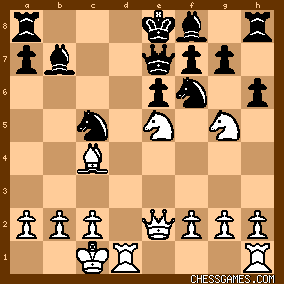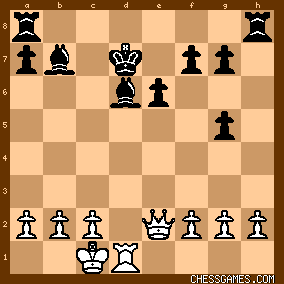|
< Earlier Kibitzing · PAGE 2 OF 2 ·
Later Kibitzing> |
| Jul-29-13 | | Conrad93: >Interesting sac 11.b4.
What would follow 14..hxg5? 14..hxg5 15.Bb5+ seems to lead to a mass exchange at d2, and I count a rook and two pieces for black against a queen and pawn . . .I liked black's defensive play, especially 18..Be4.
Final move is simple but piquant.>
Your so claimed "bad move" refutes the entire gambit. 
click for larger view14...hxg4! 15. Bb5+ Nfd7 16. Rxd7! Nxd7 17. Bxd7 Qxd7!! (17...Kc8! is another safe option; probably better) 18. Nxd7 Kxd7 19. Rd8+ Bd6 
click for larger viewBlack is better off due to his material superiority. |
|
| Jul-29-13 | | Conrad93: I swear some chess players here are idiots. If you honestly think that a rook and a queen can win in this position, you need your brain examined. |
|
Jul-30-13
 | | perfidious: Never saw this game till now, in which Flohr defends well after what appears a dubious opening idea (7....Qe7). <Conrad93: I swear some chess players here are idiots....> Trying to prove your own point, are you? |
|
| Jul-30-13 | | talisman: <Conrad93> Stein??...Flohr?...Man you must be good!!! |
|
Jul-30-13
 | | perfidious: <talisman>: <Conrad> has a short memory, unless he's one of those types who emerged from the womb as a 2500 player. |
|
| Jul-31-13 | | Conrad93: This is covered in Adrew Soltis's book. The reality is that Flohr got lucky against an unstable opponent. Stein played the better game. |
|
Jul-31-13
 | | HeMateMe: Which Soltis book? |
|
| Jul-31-13 | | Conrad93: His most famous one. |
|
Jul-31-13
 | | HeMateMe: How cryptic. He has some 90 books. Are you referring to his history of the USA championship, or his history of the USSR championship? Those are his best. |
|
| Aug-01-13 | | Conrad93: No, those are his worst. |
|
Aug-01-13
 | | perfidious: One wonders whether any author, GM or both has ever done <anything> at all worthwhile in the eyes of <Conrad>. |
|
Aug-01-13
 | | perfidious: The position in the latter diagram above is, contrary to <Conrad>'s claim, almost certainly better for White after 20.Qb5+ Bc6 21.Qxg5. It is not easy for the black king to find shelter and White's queen is active here. Once the pawn at g7 comes off, Black's precarious king position is underscored. |
|
| Aug-02-13 | | Conrad93: Perfidious is showing his ignorance. If he took the time to play it out, he would easily see that four pieces are better than two, even when a queen is involved. The capture of the g pawn is not an issue, since the queen is pretty much powerless after that petty attack. Anyways, try to back up your claims with some analysis. |
|
| Aug-02-13 | | Conrad93: By the way, I already checked that out. The queen may be able to capture the pawn, but black is still better off after the king comes into play. White may be able to somehow get perpetual check, but he is certainly not better. |
|
| Jul-07-14 | | Caissanist: This game is featured in Soltis's <The Art of Defense in Chess>, presumably that is the book that <Conrad93> is referring to. |
|
| Sep-23-16 | | N.O.F. NAJDORF: This game was featured in an obituary to Shtein in the British monthly 'Chess,' edited by B.H. Wood, in 1973. |
|
Feb-26-17
 | | Retireborn: Flohr misplays the opening, and Stein misses the win, which was to be had by 19.Bb5+! according to Houdini. After 19.Qh5+ he has no real advantage, surprisingly. He could have tried 20.Nxg6, but after 20...Qg5 21.Qxg5 hxg5 22.Nxh8 Bg7 23.Bxe6 Rb8! (with a mating threat on b2) the black pieces are sufficiently active for compensation. 33.Rf1 is a blunder, but after the correct 33.Rd7 Bxc4 34.Qxc4+ Kh8 35.Rxh7+ Kxh7 the position can only be called unclear. As for the 14...hxg5 controversy, I certainly agree with <perfidious> assessment after 21.Qxg5, but 17...Kd8! is indeed an improvement and Houdini rates the position as equal then. 16.Nxd7 (instead of 16.Rxd7) would lose to the charming 16...0-0-0! One of my favourite games, which showcases the ingenuity of both players. |
|
Jul-20-21
 | | keypusher: Couple of notes from SF14.
Amazingly, it sides with perfidious over conrad in evaluating the position in the alternative line after 21.Qxg5. Note that in this continuation 17....Kd8 loses to 18.Bc6! The engine agrees that 19.Bb5+ is strongest, but thinks 19.Qh5+ is also winning. Instead of 23.Qc6, White had 23.Rhf1!! and if ...Bxc5 24.Rxf4+ Kg8 25.Rg4 Kf7 26.Rf1+ Bf5 27.Rc4 and White wins back his piece in light of the direct threat to the bishop on c5 and the indirect threat to the bishop on f5. |
|
Jul-20-21
 | | perfidious: <keypusher.....Amazingly, it sides with perfidious over conrad in evaluating the position in the alternative line after 21.Qxg5....> Reading this was bust-a-gut stuff.
Has to be a first time. |
|
Jul-20-21
 | | Retireborn: <keypusher> Many thanks for that. I've corrected my own notes to the game. Houdini 6 agrees; evidently it sees a bit more than Houdini 1 did in 2017! |
|
Jul-20-21
 | | keypusher: < Retireborn: <keypusher> Many thanks for that. I've corrected my own notes to the game.
Houdini 6 agrees; evidently it sees a bit more than Houdini 1 did in 2017!> Good! Agree with you that this is an amazing game -- not often, as you point out, that a game can be a showcase for both players. I came across it via a 1980 Soviet bio of Stein by Gufeld and Lazarev. Not having the benefit of engines, they missed 19.Bb5+. |
|
Jul-20-21
 | | perfidious: <Retireborn....Houdini 6 agrees; evidently it sees a bit more than Houdini 1 did in 2017!> Surprised really that four years can spell so much progress, but this was a remarkably complex struggle, filled with vicissitudes, and does credit to both contestants. |
|
Nov-11-22
 | | gezafan: Even though he could have lost I'm still impressed with Flohr's defensive abilities. It seems he deliberately provoked a pretty good attacking player and, when the smoke cleared, came away with a win. |
|
| Jan-16-23 | | N.O.F. NAJDORF: What would have been wrong with
30. Qxa7 Rf6 31. g4 ? |
|
| Jan-16-23 | | N.O.F. NAJDORF: <Keypusher: White had 23.Rhf1!! and if ...Bxc5 24.Rxf4+ Kg8 25.Rg4 Kf7 26.Rf1+ Bf5 27.Rc4 and White wins back his piece in light of the direct threat to the bishop on c5 and the indirect threat to the bishop on f5.> After 23. Rhf1 Bxc5 24. Rxf4+ Kg8 25. Rg4 Kf7 26. Rf1+ Bf5 27. Rc4 Bd6 28. g4 Bxh2 29. gxf5 exf5 30. Rxf5+ Ke6 31. Rf1 white is only a pawn up. |
|
 |
|
< Earlier Kibitzing · PAGE 2 OF 2 ·
Later Kibitzing> |





